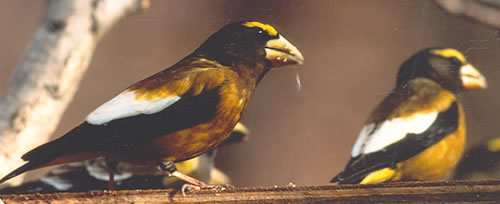Company
is coming, but what to feed them? They will be hungry and
probably bring their friends along. You search the cupboards
and find some peanut butter, shelled sunflower seeds, and
a half-bag of millet. Perfect! Lucky for you these visitors
are not your relatives, but feathered friends.
Feeding birds is way beyond throwing some old bread crumbs out the door.
Extensive studies have been conducted to determine the type of feed preferred
by various species, and also how much money Americans spend on this hobby.
Or maybe it should be called a habit. For in 1996, according to the National
Survey of Fishing, Hunting, and Wildlife-Associated Recreation, Americans
spent twenty billion more dollars in this category than they did buying
new cars. Out of this over $100 billion industry, over $31 billion was
spent on wildlife watching activities, with bird feeding and bird watching
commanding some 80 percent of that amount. This isn’t some retirement
leisure activity industry; it is a serious outdoor pursuit that has surpassed
the typical fishing and hunting outdoor markets.
Though you won’t see prime time commercials for wild birdseed mixes,
at least not tomorrow, this market deserves attention. And it’s
not just about birdseed. Serious birders travel extensively, landscape
their properties to attract birds and other wildlife species, and purchase
a number of goods and services in their quest to watch birds. Feeding
birds, by far a very popular pastime, is enjoyed by over 50 million participants.
Human participants, that is.
Where to start on your new hobby? Options and opinions can overwhelm
you in your quest to join this group, but remember it is supposed to
be fun. At your local hardware or garden shop that carries bird feeding
supplies you will find a wide variety of feeder types, seed mixes, advice,
and prices. Want a designer-built birdhouse that will be the envy of
the neighborhood? Got it. Want a seed mix and feeding tube that will
attract goldfinches but not house finches? Got it. Though the choices
seem outrageous, you have to remember that the diversity of birds in
your backyard is as great as the diversity of opinions during the upcoming
November election.
If you are a fledgling bird watcher, do a little research. Ask members
of the local bird club what types of birds are found in the area and
what those birders feed their flocks. Check out books from the library,
and visit the local stores that specialize on birds or domestic pets.
Avoid the impulse to purchase those really cheap bags of “wild
bird seed” for they are just that – many contain seeds that
birds turn their noses, I mean beaks, up at. Other considerations are
the characteristics of your yard and the amount of money and time that
you wish to spend on this engaging activity.
I tend to do several different things not only to attract birds to my
yard, but to also set them up for photographic opportunities. I also
keep in mind that I can stop at anytime (already shattering one of the “golden
rules of bird feeding”) and that the winter season isn’t
the only appropriate season to feed birds (another rule smashed!). Birds
will take advantage of artificial seed sources when they exist, and they
will seek these artificial sources in summer more so than in the winter.
So with these rules set to the side, I proceed with setting out tube
feeders, platforms, pine cones and, my favorite one, throwing seed on
the ground.
For hanging feeders I use the tube types that have small perches and
slit feeding ports. Into these I place niger thistle seed to attract
goldfinches and pine siskins. The narrow ports frustrate the house finches
and house sparrows, feeding station gluttons, because they have to feed
upside down. I place these tubes in areas where the birds can access
either escape routes from predators or nearby cover in which to hide.
For once one starts to feed birds, you have to assume that predators
will also come looking for a meal. “If you build it they will come” includes
the ballplayers, the fans, the vendors, and the scalpers selling tickets.
Another favorite feeder of mine is a platform placed about 3 feet off
the ground. The height doesn’t matter except to satisfy my photographic
interests. Most of the birds that come to this feeder, made from scrap
lumber, will also feed from the ground. Cats are an issue with this type
of feeder, as they are no different that the hawks that cruise through
the yard. I don’t really have a good solution for them other than
a shout or a tossed bucket of water.
My pine cone feeders are a cheap (i.e. free) type that I use to attract
birds that might not come to the seed feeders. These cones are slathered
in peanut butter, then rolled in a mixture of seeds and chopped nuts.
A string is attached to the top of the cone so I can hang them anywhere
in the yard, preferably in a photogenic location. Woodpeckers, jays,
nuthatches and magpies have all visited these cones, and I add some tree
limbs near the cones to create additional perching photo opportunities.
Lastly, I spread a mix of sunflower seed and white proset millet on the
ground. This is the cheapest feeder of them all, and there are a number
of birds that feed on the ground anyway. I place a brush pile near the
seed area for cover and for a pleasing photographic background. Though
I might place a tube feeder above the ground station, I don’t expect
the perching birds to go after the ground food, or vice versa.
So this fall when you are buying groceries for unexpected company, don’t
forget to include a few extra ingredients to satisfy those that fly in
for a visit. The banquet you prepare for your visiting friends will provide
you with endless enjoyment as you watch the antics and activities of
these feeding feathered creatures. |
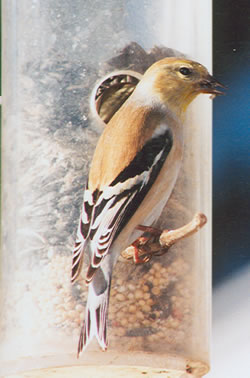
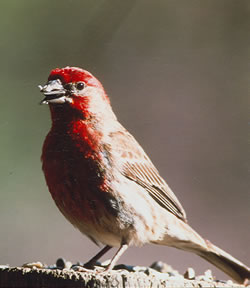
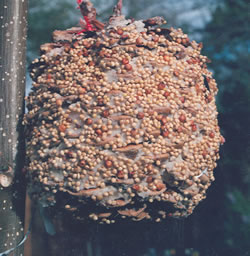
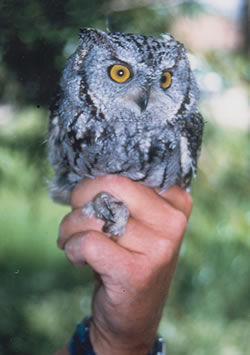
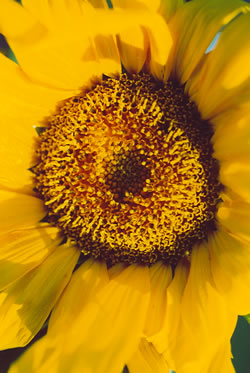
|






